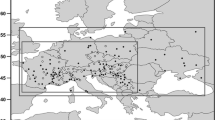Abstract
The 2001 grass pollen season in the United Kingdom was notably severe. An epidemic of foot and mouth disease (FMD) occurred in the UK during February and spread through the country during the summer. The media claimed that the control measures of culling infected animals and the restricted movement of stock, led to reduced grazing allowing pastures to flower more than in previous years. This study aimed to examine whether the severity was due only to weather factors or if the control measures also contributed. Three pollen sites from the FMD-affected Midlands region were investigated and compared with two sites from regions unaffected for differences in pollen catches, culling levels and weather. The June pollen catch in the Midlands was particularly high but this pattern also features in areas such as Cambridge in the East that were minimally affected by the epidemic. In most of the catchment areas affected by FMD the quantity of animals culled was less than 10% of the total livestock. In areas where culling was concentrated we can assume that there would have been some localized affect on the pollen levels. The results show that the main influencing variable on the 2001 grass pollen counts in the Midlands was the weather and that culling due to the foot and mouth epidemic did not exert an important influence at the regional level.
Similar content being viewed by others
References
British Aerobiology Federation: 1995, Airborne Pollen and Spores: A Guide to Trapping and Counting. Kimberly Clark Ltd.: Aylesford.
Davies G.: 2002, The foot and mouth disease (FMD) epidemic in the UK, 2001. Compar. Immunol., Microbiol. Infect. Dis. 25, 331–344.
Emberlin J.: 1997, Grass, tree and weed pollens. In B. Kay (ed.), Allergy and Allergic Rhinitis, Vol. 2. Blackwell Science: Oxford, pp. 835–858.
Emberlin J.: 2000, Aerobiology. In W.W. Busse and S. Holgate (eds), Asthma and Rhinitis, Vol. 2. Blackwell Science: Oxford, pp. 1083–1106.
Emberlin J., Savage M. and Jones S.: 1993, Annual variations in grass pollen seasons in London 1961–1990: Trends and forecast models. Clin. Exp. Allergy 23, 911–918.
Faegri K. and Iversen J.: 1992, Textbook of Pollen Analysis. John Wiley and Sons: New York.
Fitter A.H., Fitter R.S.R., Harris I.T.B. and Williamson M.H.: 1995, Relationships between first flowering date and temperature in the flora of a locality in central England. Funct. Ecol. 9, 55–60.
Gloster J., Champion H.J., Ryall D.B. and Brown A.R.: 2004, The 2001 UK epidemic of foot-and-mouth disease – a meteorological review: Part 1. Weather 59, 8–11.
Holmes W.: 1989, Grass: It’s Production and Utilization. Blackwell Scientific Publications: Oxford.
Thibaudon M. and Laaidi M.: 2002, Study of the pollen season of Poaceae in France in 2001. Allergie Immunl. 24, 117–121.
Author information
Authors and Affiliations
Rights and permissions
About this article
Cite this article
Emberlin, J., Adams-Groom, B. An analysis of the possible effects of the 2001 foot and mouth disease epidemic on grass pollen concentrations in the Midlands, UK. Aerobiologia 20, 209–216 (2004). https://doi.org/10.1007/s10453-004-1184-1
Issue Date:
DOI: https://doi.org/10.1007/s10453-004-1184-1




